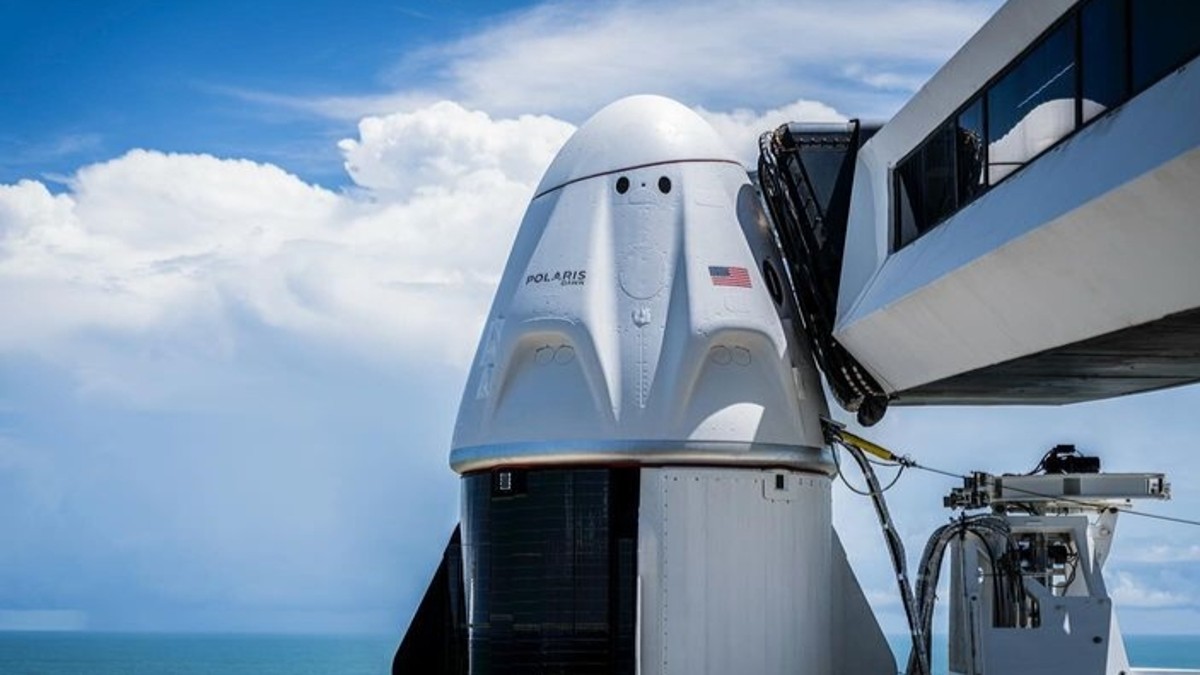
SpaceX
SpaceX’s Polaris Dawn mission launched successfully, marking a historic moment in private space exploration. The mission, commanded by billionaire entrepreneur Jared Isaacman, took off from NASA’s Kennedy Space Center aboard a SpaceX Falcon 9 rocket on September 9, 2024. The crew of four civilians will spend five days in space, traveling farther than any humans have since the Apollo missions in the 1970s. They are set to reach an altitude of 870 miles, passing through Earth’s Van Allen radiation belts, which are known to pose significant challenges due to cosmic radiation.
A key highlight of the Polaris Dawn mission is the planned spacewalk on the third day, the first-ever private spacewalk in history. This will be conducted using SpaceX’s new, slimmer spacesuits. Jared Isaacman and SpaceX engineer Sarah Gillis will perform the spacewalk while tethered to the spacecraft, while the other two crew members, pilot Scott “Kidd” Poteet and SpaceX engineer Anna Menon, will remain inside the Crew Dragon capsule.
The mission’s objectives include conducting 36 research studies focused on understanding the effects of spaceflight on human health, both for astronauts and for long-term missions in space. These studies could provide vital data for future human space exploration, particularly concerning the effects of cosmic radiation on the human body.
The Polaris Dawn mission is part of a broader initiative funded by Isaacman, who is financing a series of private spaceflights under the Polaris Program. This marks his second space mission, following the successful Inspiration4 mission in 2021.
This mission also carries increased risks, given the unprecedented nature of the private spacewalk and the high-altitude orbit, which will expose the crew to conditions that haven’t been experienced by humans in over 50 years. Despite these challenges, the mission represents a significant step forward for private space exploration and commercial spaceflight
The Polaris Dawn mission, besides being a groundbreaking space venture, is a bold step in advancing human space exploration and commercializing space activities. SpaceX, under Elon Musk’s leadership, has consistently pushed the envelope of space innovation, and this mission is no different. One of its central goals is to test new technologies and gather critical data that will help in future deep-space exploration.
Crew and Leadership
The crew, led by Jared Isaacman, includes experienced individuals from both military and space sectors. Isaacman, a billionaire entrepreneur and experienced pilot, is joined by Scott “Kidd” Poteet, a retired U.S. Air Force lieutenant colonel and mission pilot. Sarah Gillis and Anna Menon, both engineers at SpaceX, round out the crew. These SpaceX employees are crucial for the mission’s technical execution, given their deep expertise in the company’s space technology.
Mission Objectives and Experiments

A major part of the Polaris Dawn mission includes conducting 36 scientific experiments, many of which are geared towards understanding how space affects the human body, particularly in high-radiation environments like the Van Allen belts. The crew will also test new Starlink communication systems that could potentially provide better data transmission and communications capabilities in space.
This mission represents a key experiment in space communications, with plans to test laser-based inter-satellite links using SpaceX’s Starlink technology. If successful, it could revolutionize how we communicate across vast distances in space, ensuring that future Mars missions or deep-space explorations are better connected with Earth.
The Spacewalk and Risks
Perhaps the most ambitious aspect of Polaris Dawn is the scheduled spacewalk, which will take place on the third day of the mission. This is the first time civilians will perform a spacewalk, marking an unprecedented event in space exploration. Newly designed SpaceX spacesuits will be used during this venture, and since the Crew Dragon capsule doesn’t have an airlock, the entire cabin will depressurize before the astronauts venture out. This adds an element of risk, as all four crew members will have to rely on their suits for life support while the spacecraft is depressurized.
Commercialization and Future of Space Travel
Polaris Dawn is one in a series of missions under Isaacman’s Polaris Program, which is designed to stretch the boundaries of human space travel and test the technology necessary for longer, more challenging journeys. In the near future, we can expect these missions to contribute to NASA’s Artemis program and other international initiatives aimed at establishing a permanent human presence on the Moon and Mars. By perfecting commercial space travel, Polaris Dawn paves the way for greater public access to space and a future where space tourism and private space exploration become more routine.
Isaacman’s financing of this mission, while the exact cost remains undisclosed, demonstrates the increasing role that private industry plays in advancing space science. The potential applications of this research could impact not only future astronauts but also space tourism, biotechnology, and space-related medical advances.
Conclusion
The Polaris Dawn mission represents a pivotal moment in the evolution of space exploration, showcasing the growing role of private companies in pushing the frontiers of human spaceflight. With a crew led by Jared Isaacman and backed by SpaceX’s advanced technology, this mission is not just a leap in terms of technological innovation but also a significant step toward making space more accessible to non-professional astronauts.
The mission’s primary objectives — from the first-ever private spacewalk to testing high-altitude orbits — emphasize the bold ambition to expand our understanding of space’s impact on human physiology and advance technologies for future deep-space travel.
The Polaris Dawn mission also highlights the shift from governmental to private-sector-led exploration. While NASA’s Apollo missions once stood as the benchmark of space exploration, today’s missions like Polaris Dawn demonstrate how private industry can contribute to long-term goals like human missions to Mars. Through its comprehensive range of experiments and technological tests, this mission has the potential to reshape space travel, inspiring further collaboration between the public and private sectors.
Ultimately, Polaris Dawn isn’t just about pushing the limits of space technology; it’s about expanding humanity’s reach into space and laying the groundwork for future generations of explorers. The mission serves as a reminder of the vast possibilities that await beyond Earth and reinforces the potential for private ventures to play a key role in humanity’s spacefaring future






